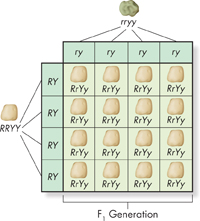Independent Assortment
 How do alleles segregate when more than one gene is involved?
How do alleles segregate when more than one gene is involved?
After showing that alleles segregate during the formation of gametes, Mendel wondered if the segregation of one pair of alleles affects another pair. For example, does the gene that determines the shape of a seed affect the gene for seed color? To find out, Mendel followed two different genes as they passed from one generation to the next. Because it involves two different genes, Mendel's experiment is known as a two-factor, or “dihybrid,” cross. (Single-gene crosses are “monohybrid” crosses.)

FIGURE 11–9 Two-Factor Cross: F1 Mendel crossed plants that were homozygous dominant for round yellow peas with plants that were homozygous recessive for wrinkled green peas. All of the F1 offspring were heterozygous dominant for round yellow peas. Interpret Graphics How is the genotype of the offspring different from that of the homozygous dominant parent?
dThe Two-Factor Cross: F1 First, Mendel crossed true-breeding plants that produced only round yellow peas with plants that produced wrinkled green peas. The round yellow peas had the genotype RRYY, and the wrinkled green peas had the genotype rryy. All of the F1 offspring produced round yellow peas. These results showed that the alleles for yellow and round peas are dominant. As the Punnett square in Figure 11–9 shows, the genotype in each of these F1 plants is RrYy. In other words, the F1 plants were all heterozygous for both seed shape and seed color. This cross did not indicate whether genes assort, or segregate independently. However, it provided the hybrid plants needed to breed the F2 generation.
The Two-Factor Cross: F2 In the second part of this experiment, Mendel crossed the F1 plants to produce F2 offspring. Remember, each F1 plant was formed by the fusion of a gamete carrying the dominant RY alleles with another gamete carrying the recessive ry alleles. Did this mean that the two dominant alleles would always stay together, or would they segregate independently, so that any combination of alleles was possible?
In Mendel's experiment, the F2 plants produced 556 seeds. Mendel compared their variation. He observed that 315 of the seeds were round and yellow, while another 32 seeds were wrinkled and green—the two parental phenotypes. However, 209 seeds had combinations of phenotypes, and therefore combinations of alleles, that were not found in either parent. This clearly meant that the alleles for seed shape segregated independently of those for seed color. Put another way, genes that segregate independently (such as the genes for seed shape and seed color in pea plants) do not influence each other's inheritance.
Mendel's experimental results were very close to the 9 : 3 : 3 : 1 ratio that the Punnett square shown in Figure 11–10 predicts. Mendel had discovered the principle of independent assortment.  The principle of independent assortment states that genes for different traits can segregate independently during the formation of gametes. Independent assortment helps account for the many genetic variations observed in plants, animals, and other organisms—even when they have the same parents.
The principle of independent assortment states that genes for different traits can segregate independently during the formation of gametes. Independent assortment helps account for the many genetic variations observed in plants, animals, and other organisms—even when they have the same parents.

FIGURE 11–10 Two-Factor Cross: F2 When Mendel crossed F1 plants that were heterozygous dominant for round yellow peas, he found that the alleles segregated independently to produce the F2 generation.
Table of Contents
- Formulas and Equations
- Applying Formulas and Equations
- Mean, Median, and Mode
- Estimation
- Using Measurements in Calculations
- Effects of Measurement Errors
- Accuracy
- Precision
- Comparing Accuracy and Precision
- Significant Figures
- Calculating With Significant Figures
- Scientific Notation
- Calculating With Scientific Notation
- Dimensional Analysis
- Applying Dimensional Analysis




